UGB 163 Accounting and Finance Report: Investment Appraisal Analysis
VerifiedAdded on 2023/01/18
|18
|3809
|89
Report
AI Summary
This report provides a comprehensive analysis of accounting and finance principles through three distinct parts. Part A focuses on Terry Joe Plc, constructing its income statement and statement of financial position. Part B delves into Kokolet Limited, examining contribution margins, break-even points, margin of safety, profit calculations, strategic assessments, and the assumptions underpinning break-even models. Finally, Part C evaluates Smith Howe Limited by calculating the payback period, accounting rate of return, and net present value of a machine investment, along with a discussion of the merits and limitations of investment appraisal techniques and budgeting as a strategic tool. The report integrates financial accounting and management accounting concepts to understand the role of finance at local and international levels.
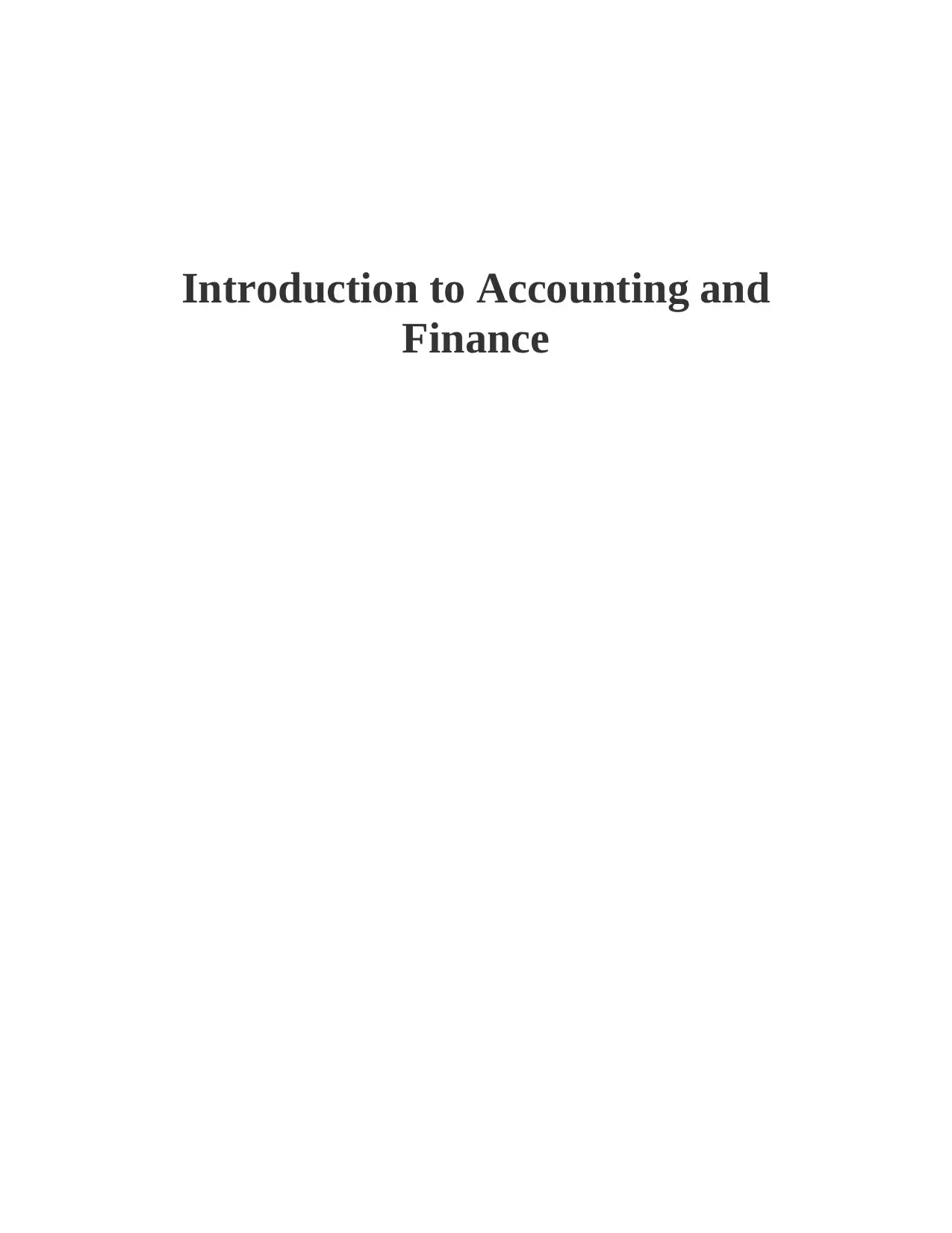
Introduction to Accounting and
Finance
Finance
Paraphrase This Document
Need a fresh take? Get an instant paraphrase of this document with our AI Paraphraser
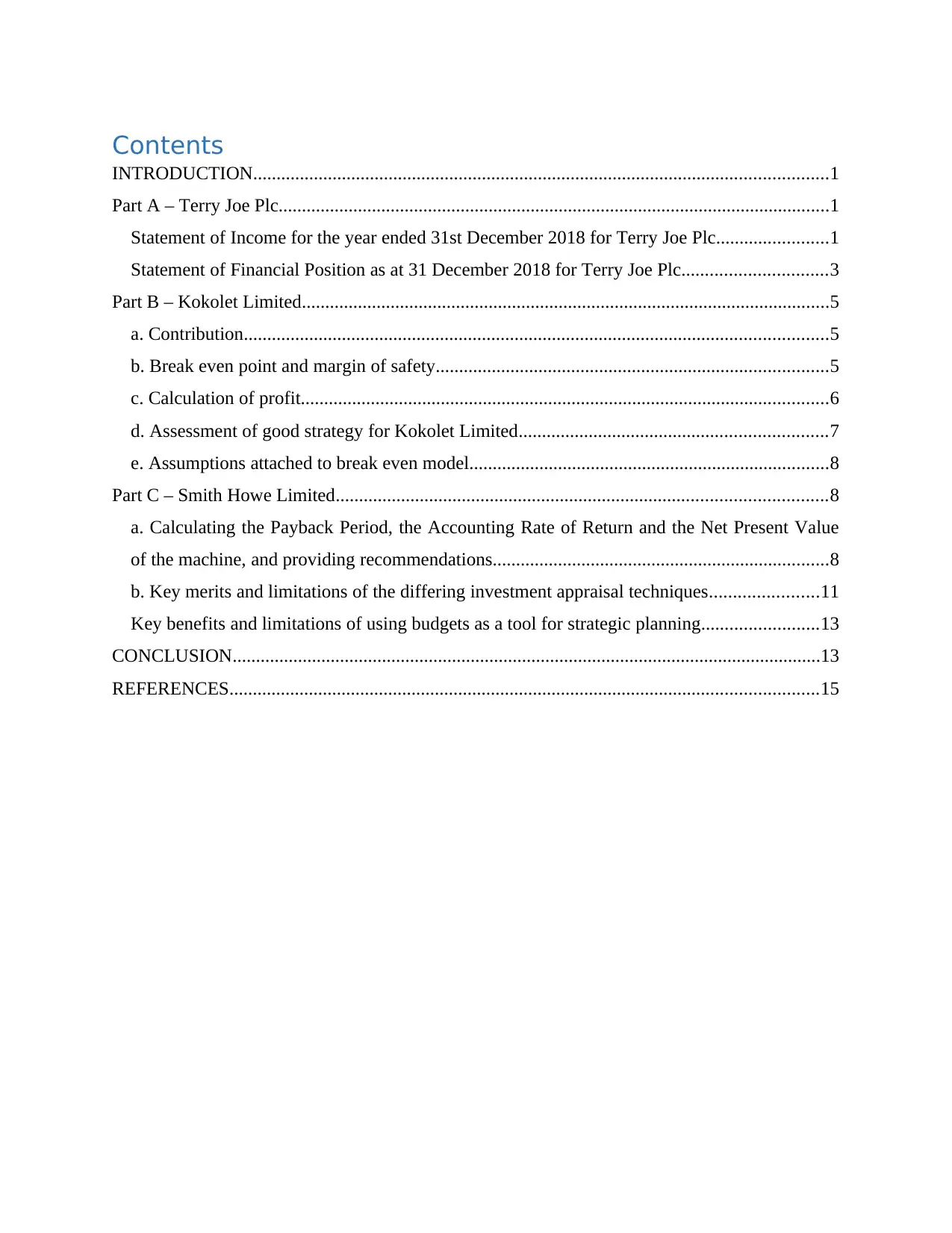
Contents
INTRODUCTION...........................................................................................................................1
Part A – Terry Joe Plc......................................................................................................................1
Statement of Income for the year ended 31st December 2018 for Terry Joe Plc........................1
Statement of Financial Position as at 31 December 2018 for Terry Joe Plc...............................3
Part B – Kokolet Limited.................................................................................................................5
a. Contribution.............................................................................................................................5
b. Break even point and margin of safety....................................................................................5
c. Calculation of profit.................................................................................................................6
d. Assessment of good strategy for Kokolet Limited..................................................................7
e. Assumptions attached to break even model.............................................................................8
Part C – Smith Howe Limited.........................................................................................................8
a. Calculating the Payback Period, the Accounting Rate of Return and the Net Present Value
of the machine, and providing recommendations........................................................................8
b. Key merits and limitations of the differing investment appraisal techniques.......................11
Key benefits and limitations of using budgets as a tool for strategic planning.........................13
CONCLUSION..............................................................................................................................13
REFERENCES..............................................................................................................................15
INTRODUCTION...........................................................................................................................1
Part A – Terry Joe Plc......................................................................................................................1
Statement of Income for the year ended 31st December 2018 for Terry Joe Plc........................1
Statement of Financial Position as at 31 December 2018 for Terry Joe Plc...............................3
Part B – Kokolet Limited.................................................................................................................5
a. Contribution.............................................................................................................................5
b. Break even point and margin of safety....................................................................................5
c. Calculation of profit.................................................................................................................6
d. Assessment of good strategy for Kokolet Limited..................................................................7
e. Assumptions attached to break even model.............................................................................8
Part C – Smith Howe Limited.........................................................................................................8
a. Calculating the Payback Period, the Accounting Rate of Return and the Net Present Value
of the machine, and providing recommendations........................................................................8
b. Key merits and limitations of the differing investment appraisal techniques.......................11
Key benefits and limitations of using budgets as a tool for strategic planning.........................13
CONCLUSION..............................................................................................................................13
REFERENCES..............................................................................................................................15

⊘ This is a preview!⊘
Do you want full access?
Subscribe today to unlock all pages.

Trusted by 1+ million students worldwide
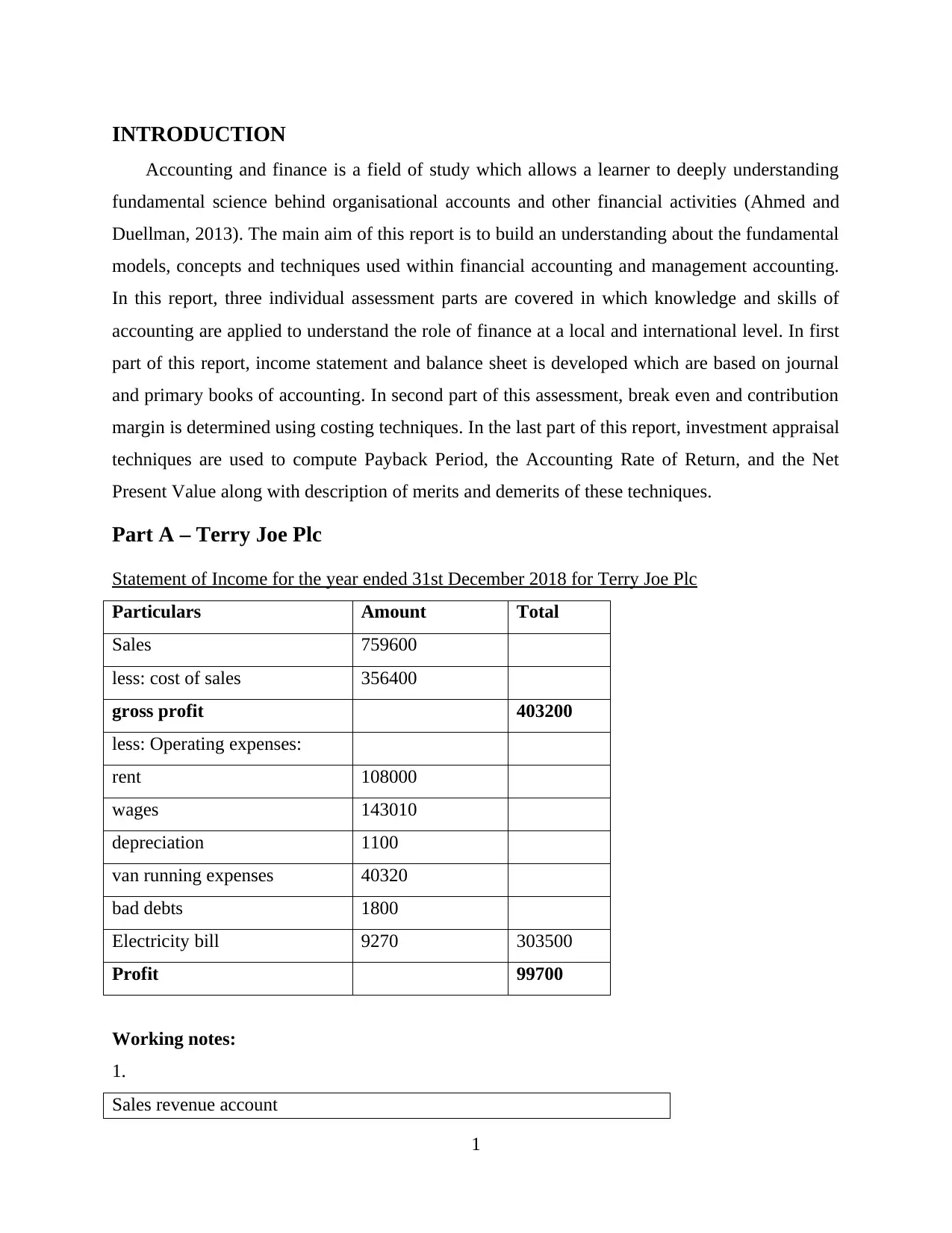
INTRODUCTION
Accounting and finance is a field of study which allows a learner to deeply understanding
fundamental science behind organisational accounts and other financial activities (Ahmed and
Duellman, 2013). The main aim of this report is to build an understanding about the fundamental
models, concepts and techniques used within financial accounting and management accounting.
In this report, three individual assessment parts are covered in which knowledge and skills of
accounting are applied to understand the role of finance at a local and international level. In first
part of this report, income statement and balance sheet is developed which are based on journal
and primary books of accounting. In second part of this assessment, break even and contribution
margin is determined using costing techniques. In the last part of this report, investment appraisal
techniques are used to compute Payback Period, the Accounting Rate of Return, and the Net
Present Value along with description of merits and demerits of these techniques.
Part A – Terry Joe Plc
Statement of Income for the year ended 31st December 2018 for Terry Joe Plc
Particulars Amount Total
Sales 759600
less: cost of sales 356400
gross profit 403200
less: Operating expenses:
rent 108000
wages 143010
depreciation 1100
van running expenses 40320
bad debts 1800
Electricity bill 9270 303500
Profit 99700
Working notes:
1.
Sales revenue account
1
Accounting and finance is a field of study which allows a learner to deeply understanding
fundamental science behind organisational accounts and other financial activities (Ahmed and
Duellman, 2013). The main aim of this report is to build an understanding about the fundamental
models, concepts and techniques used within financial accounting and management accounting.
In this report, three individual assessment parts are covered in which knowledge and skills of
accounting are applied to understand the role of finance at a local and international level. In first
part of this report, income statement and balance sheet is developed which are based on journal
and primary books of accounting. In second part of this assessment, break even and contribution
margin is determined using costing techniques. In the last part of this report, investment appraisal
techniques are used to compute Payback Period, the Accounting Rate of Return, and the Net
Present Value along with description of merits and demerits of these techniques.
Part A – Terry Joe Plc
Statement of Income for the year ended 31st December 2018 for Terry Joe Plc
Particulars Amount Total
Sales 759600
less: cost of sales 356400
gross profit 403200
less: Operating expenses:
rent 108000
wages 143010
depreciation 1100
van running expenses 40320
bad debts 1800
Electricity bill 9270 303500
Profit 99700
Working notes:
1.
Sales revenue account
1
Paraphrase This Document
Need a fresh take? Get an instant paraphrase of this document with our AI Paraphraser
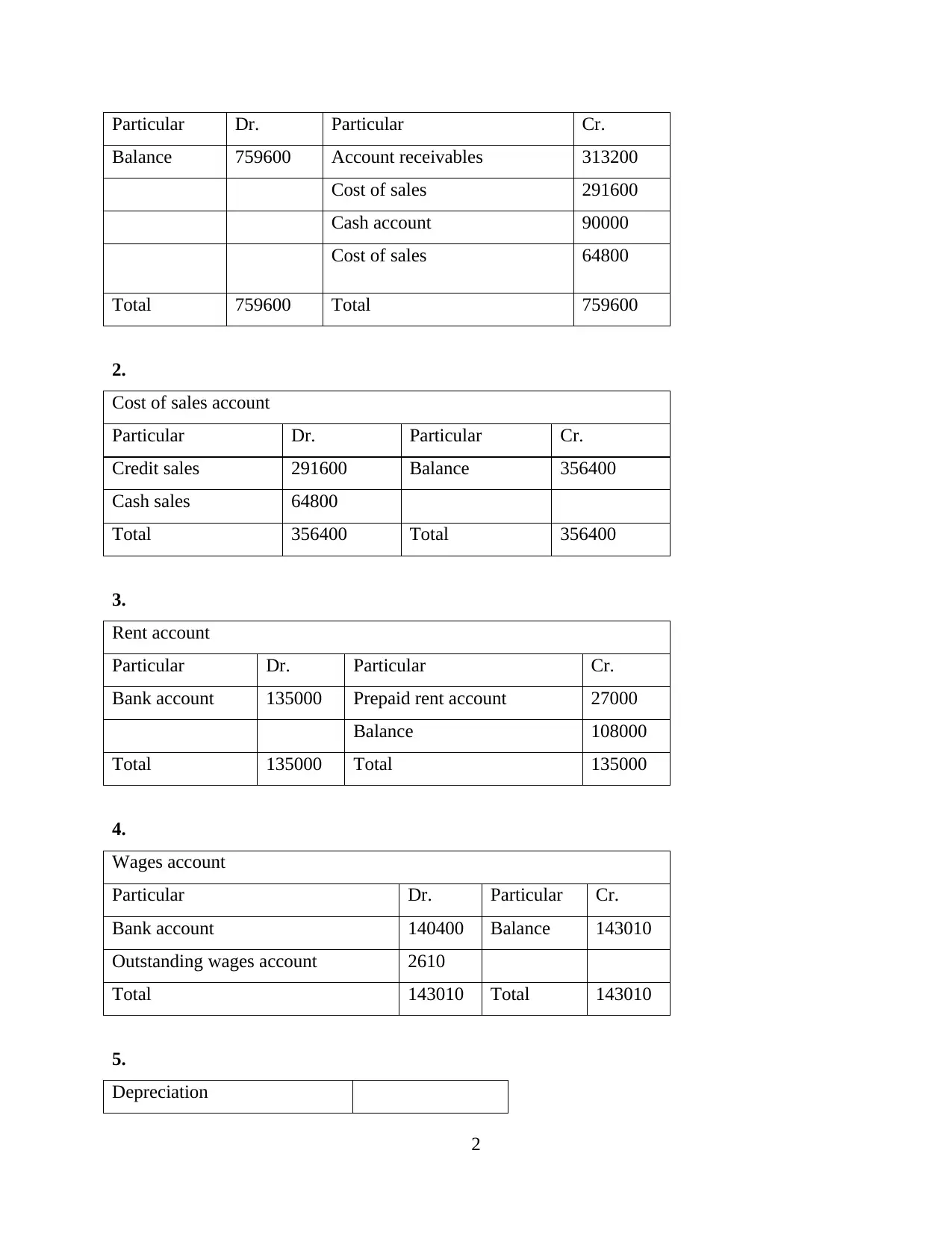
Particular Dr. Particular Cr.
Balance 759600 Account receivables 313200
Cost of sales 291600
Cash account 90000
Cost of sales 64800
Total 759600 Total 759600
2.
Cost of sales account
Particular Dr. Particular Cr.
Credit sales 291600 Balance 356400
Cash sales 64800
Total 356400 Total 356400
3.
Rent account
Particular Dr. Particular Cr.
Bank account 135000 Prepaid rent account 27000
Balance 108000
Total 135000 Total 135000
4.
Wages account
Particular Dr. Particular Cr.
Bank account 140400 Balance 143010
Outstanding wages account 2610
Total 143010 Total 143010
5.
Depreciation
2
Balance 759600 Account receivables 313200
Cost of sales 291600
Cash account 90000
Cost of sales 64800
Total 759600 Total 759600
2.
Cost of sales account
Particular Dr. Particular Cr.
Credit sales 291600 Balance 356400
Cash sales 64800
Total 356400 Total 356400
3.
Rent account
Particular Dr. Particular Cr.
Bank account 135000 Prepaid rent account 27000
Balance 108000
Total 135000 Total 135000
4.
Wages account
Particular Dr. Particular Cr.
Bank account 140400 Balance 143010
Outstanding wages account 2610
Total 143010 Total 143010
5.
Depreciation
2
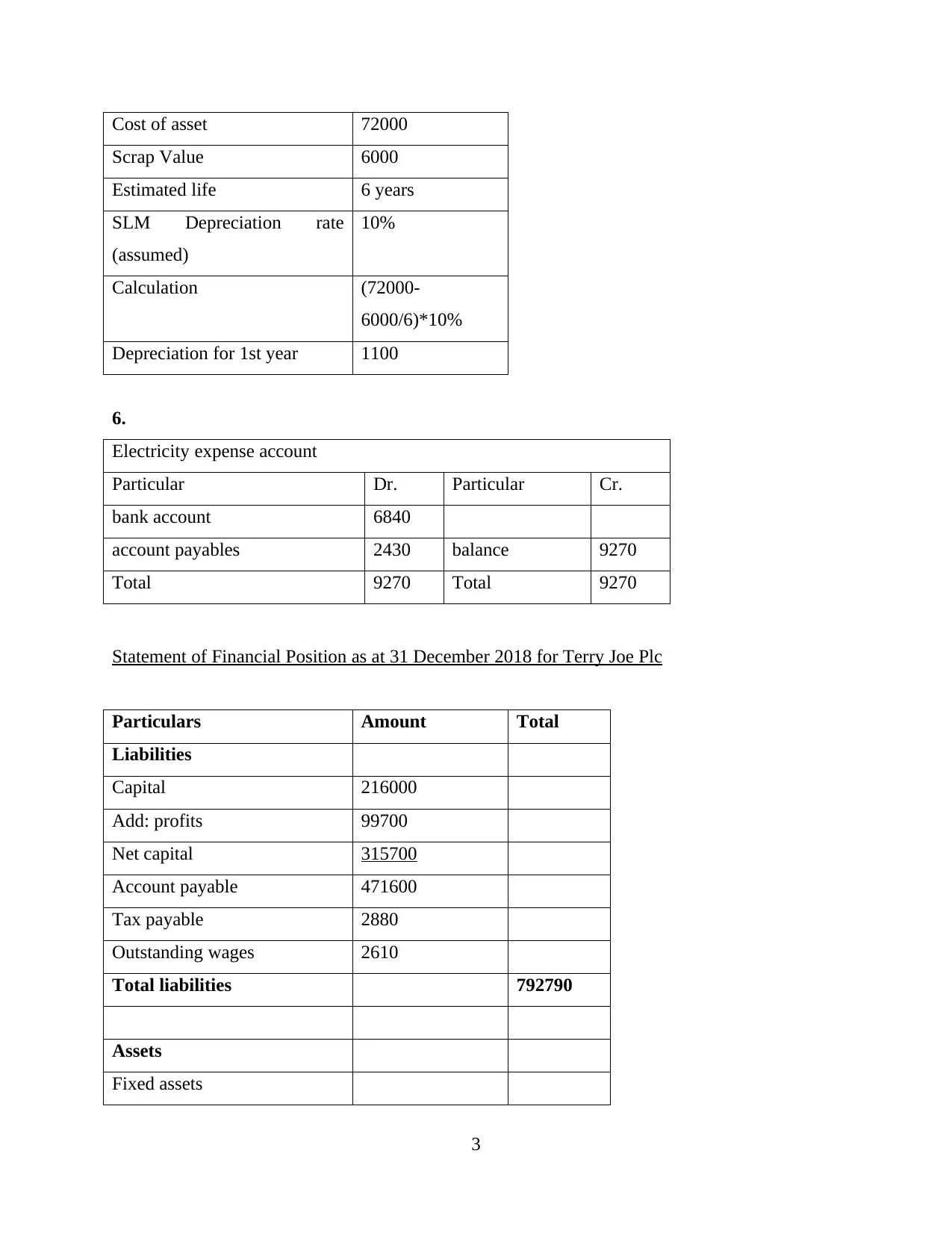
Cost of asset 72000
Scrap Value 6000
Estimated life 6 years
SLM Depreciation rate
(assumed)
10%
Calculation (72000-
6000/6)*10%
Depreciation for 1st year 1100
6.
Electricity expense account
Particular Dr. Particular Cr.
bank account 6840
account payables 2430 balance 9270
Total 9270 Total 9270
Statement of Financial Position as at 31 December 2018 for Terry Joe Plc
Particulars Amount Total
Liabilities
Capital 216000
Add: profits 99700
Net capital 315700
Account payable 471600
Tax payable 2880
Outstanding wages 2610
Total liabilities 792790
Assets
Fixed assets
3
Scrap Value 6000
Estimated life 6 years
SLM Depreciation rate
(assumed)
10%
Calculation (72000-
6000/6)*10%
Depreciation for 1st year 1100
6.
Electricity expense account
Particular Dr. Particular Cr.
bank account 6840
account payables 2430 balance 9270
Total 9270 Total 9270
Statement of Financial Position as at 31 December 2018 for Terry Joe Plc
Particulars Amount Total
Liabilities
Capital 216000
Add: profits 99700
Net capital 315700
Account payable 471600
Tax payable 2880
Outstanding wages 2610
Total liabilities 792790
Assets
Fixed assets
3
⊘ This is a preview!⊘
Do you want full access?
Subscribe today to unlock all pages.

Trusted by 1+ million students worldwide
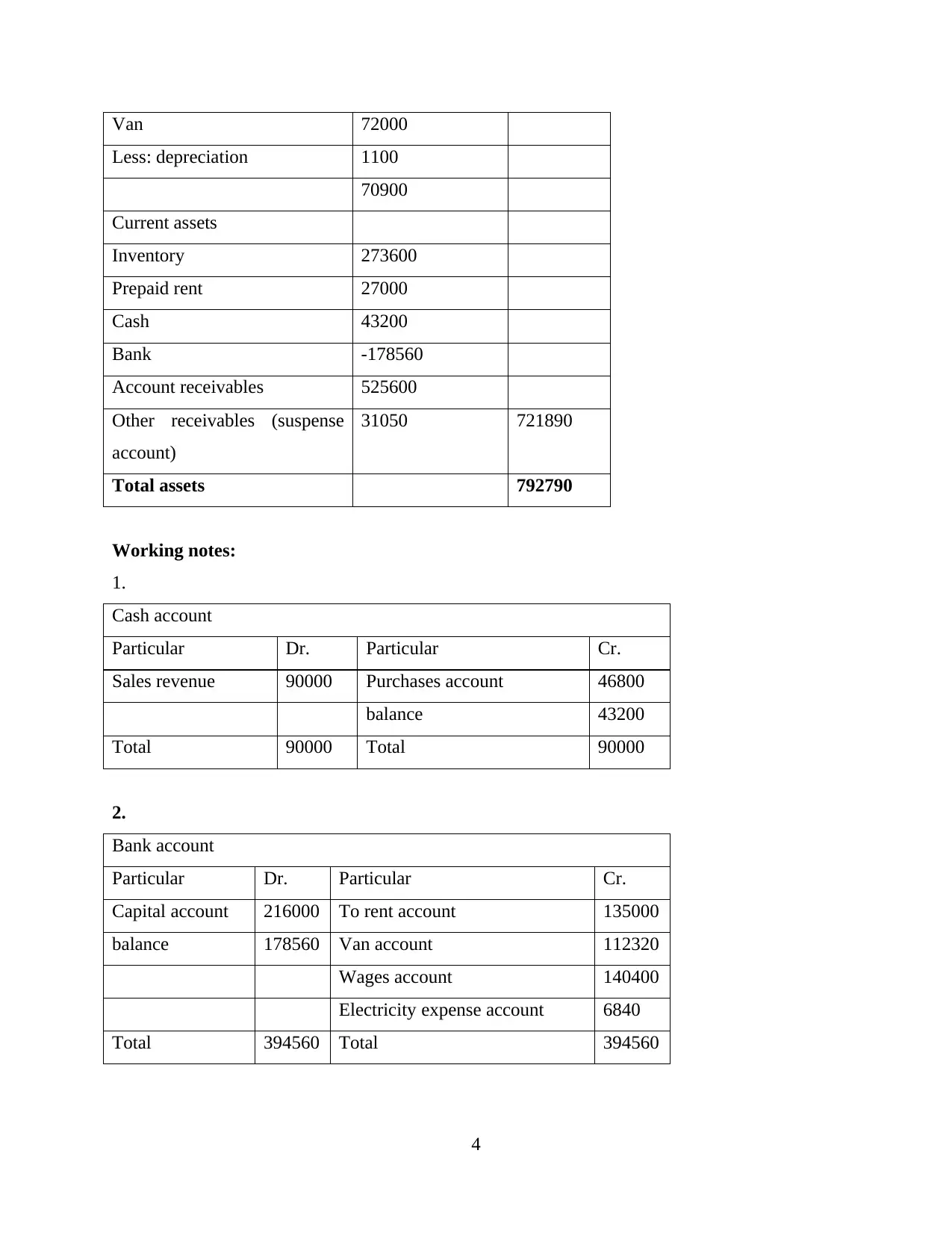
Van 72000
Less: depreciation 1100
70900
Current assets
Inventory 273600
Prepaid rent 27000
Cash 43200
Bank -178560
Account receivables 525600
Other receivables (suspense
account)
31050 721890
Total assets 792790
Working notes:
1.
Cash account
Particular Dr. Particular Cr.
Sales revenue 90000 Purchases account 46800
balance 43200
Total 90000 Total 90000
2.
Bank account
Particular Dr. Particular Cr.
Capital account 216000 To rent account 135000
balance 178560 Van account 112320
Wages account 140400
Electricity expense account 6840
Total 394560 Total 394560
4
Less: depreciation 1100
70900
Current assets
Inventory 273600
Prepaid rent 27000
Cash 43200
Bank -178560
Account receivables 525600
Other receivables (suspense
account)
31050 721890
Total assets 792790
Working notes:
1.
Cash account
Particular Dr. Particular Cr.
Sales revenue 90000 Purchases account 46800
balance 43200
Total 90000 Total 90000
2.
Bank account
Particular Dr. Particular Cr.
Capital account 216000 To rent account 135000
balance 178560 Van account 112320
Wages account 140400
Electricity expense account 6840
Total 394560 Total 394560
4
Paraphrase This Document
Need a fresh take? Get an instant paraphrase of this document with our AI Paraphraser
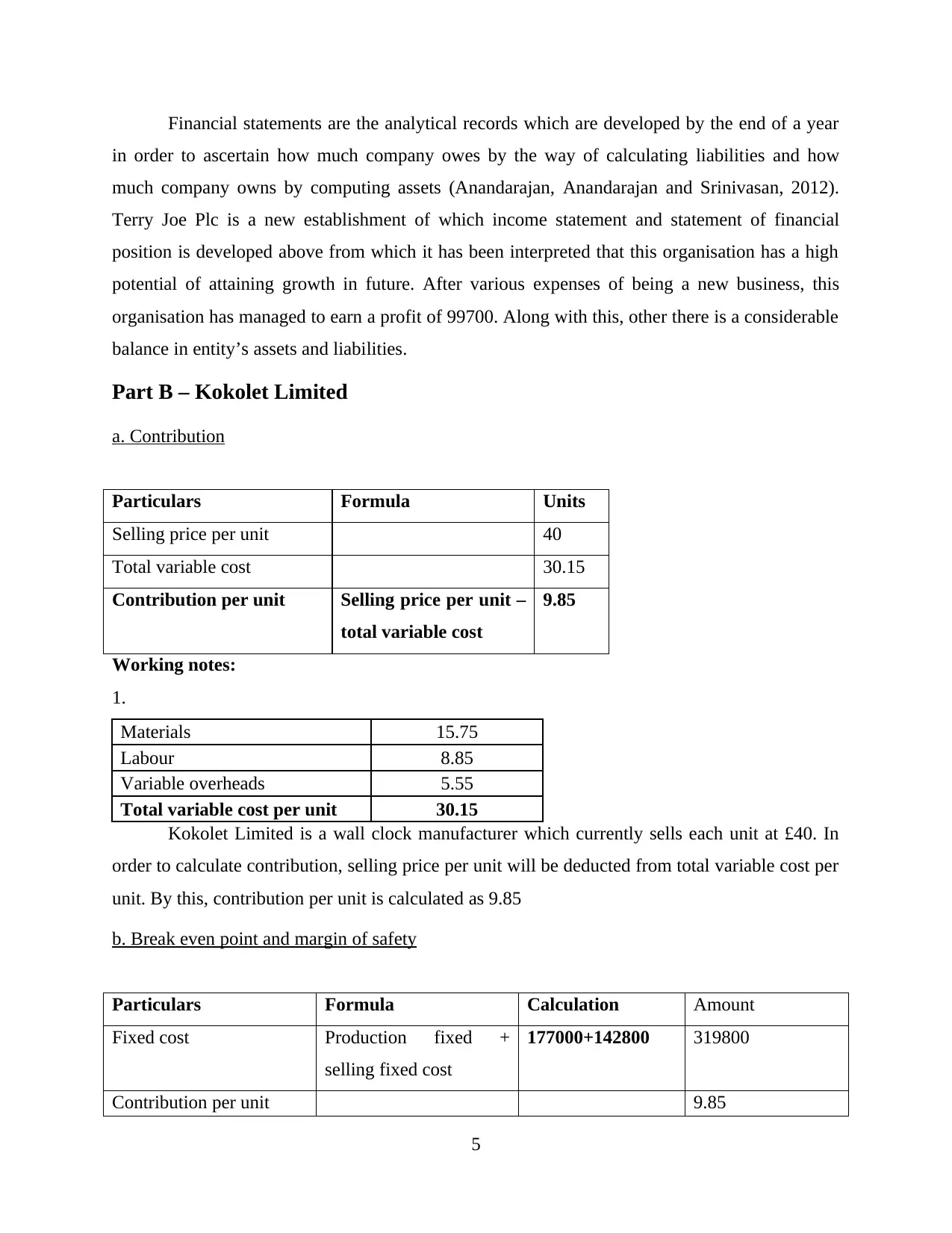
Financial statements are the analytical records which are developed by the end of a year
in order to ascertain how much company owes by the way of calculating liabilities and how
much company owns by computing assets (Anandarajan, Anandarajan and Srinivasan, 2012).
Terry Joe Plc is a new establishment of which income statement and statement of financial
position is developed above from which it has been interpreted that this organisation has a high
potential of attaining growth in future. After various expenses of being a new business, this
organisation has managed to earn a profit of 99700. Along with this, other there is a considerable
balance in entity’s assets and liabilities.
Part B – Kokolet Limited
a. Contribution
Particulars Formula Units
Selling price per unit 40
Total variable cost 30.15
Contribution per unit Selling price per unit –
total variable cost
9.85
Working notes:
1.
Materials 15.75
Labour 8.85
Variable overheads 5.55
Total variable cost per unit 30.15
Kokolet Limited is a wall clock manufacturer which currently sells each unit at £40. In
order to calculate contribution, selling price per unit will be deducted from total variable cost per
unit. By this, contribution per unit is calculated as 9.85
b. Break even point and margin of safety
Particulars Formula Calculation Amount
Fixed cost Production fixed +
selling fixed cost
177000+142800 319800
Contribution per unit 9.85
5
in order to ascertain how much company owes by the way of calculating liabilities and how
much company owns by computing assets (Anandarajan, Anandarajan and Srinivasan, 2012).
Terry Joe Plc is a new establishment of which income statement and statement of financial
position is developed above from which it has been interpreted that this organisation has a high
potential of attaining growth in future. After various expenses of being a new business, this
organisation has managed to earn a profit of 99700. Along with this, other there is a considerable
balance in entity’s assets and liabilities.
Part B – Kokolet Limited
a. Contribution
Particulars Formula Units
Selling price per unit 40
Total variable cost 30.15
Contribution per unit Selling price per unit –
total variable cost
9.85
Working notes:
1.
Materials 15.75
Labour 8.85
Variable overheads 5.55
Total variable cost per unit 30.15
Kokolet Limited is a wall clock manufacturer which currently sells each unit at £40. In
order to calculate contribution, selling price per unit will be deducted from total variable cost per
unit. By this, contribution per unit is calculated as 9.85
b. Break even point and margin of safety
Particulars Formula Calculation Amount
Fixed cost Production fixed +
selling fixed cost
177000+142800 319800
Contribution per unit 9.85
5
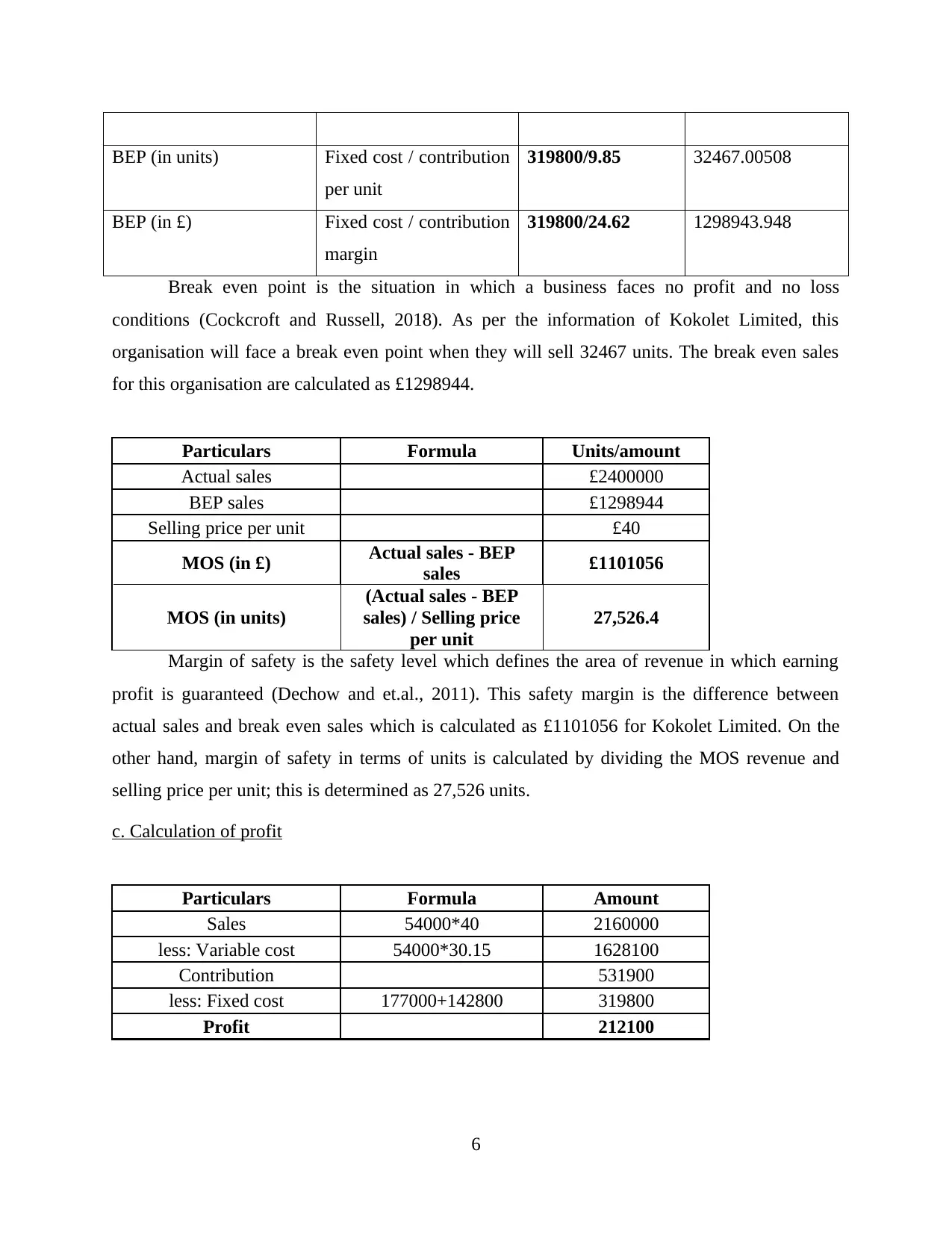
BEP (in units) Fixed cost / contribution
per unit
319800/9.85 32467.00508
BEP (in £) Fixed cost / contribution
margin
319800/24.62 1298943.948
Break even point is the situation in which a business faces no profit and no loss
conditions (Cockcroft and Russell, 2018). As per the information of Kokolet Limited, this
organisation will face a break even point when they will sell 32467 units. The break even sales
for this organisation are calculated as £1298944.
Particulars Formula Units/amount
Actual sales £2400000
BEP sales £1298944
Selling price per unit £40
MOS (in £) Actual sales - BEP
sales £1101056
MOS (in units)
(Actual sales - BEP
sales) / Selling price
per unit
27,526.4
Margin of safety is the safety level which defines the area of revenue in which earning
profit is guaranteed (Dechow and et.al., 2011). This safety margin is the difference between
actual sales and break even sales which is calculated as £1101056 for Kokolet Limited. On the
other hand, margin of safety in terms of units is calculated by dividing the MOS revenue and
selling price per unit; this is determined as 27,526 units.
c. Calculation of profit
Particulars Formula Amount
Sales 54000*40 2160000
less: Variable cost 54000*30.15 1628100
Contribution 531900
less: Fixed cost 177000+142800 319800
Profit 212100
6
per unit
319800/9.85 32467.00508
BEP (in £) Fixed cost / contribution
margin
319800/24.62 1298943.948
Break even point is the situation in which a business faces no profit and no loss
conditions (Cockcroft and Russell, 2018). As per the information of Kokolet Limited, this
organisation will face a break even point when they will sell 32467 units. The break even sales
for this organisation are calculated as £1298944.
Particulars Formula Units/amount
Actual sales £2400000
BEP sales £1298944
Selling price per unit £40
MOS (in £) Actual sales - BEP
sales £1101056
MOS (in units)
(Actual sales - BEP
sales) / Selling price
per unit
27,526.4
Margin of safety is the safety level which defines the area of revenue in which earning
profit is guaranteed (Dechow and et.al., 2011). This safety margin is the difference between
actual sales and break even sales which is calculated as £1101056 for Kokolet Limited. On the
other hand, margin of safety in terms of units is calculated by dividing the MOS revenue and
selling price per unit; this is determined as 27,526 units.
c. Calculation of profit
Particulars Formula Amount
Sales 54000*40 2160000
less: Variable cost 54000*30.15 1628100
Contribution 531900
less: Fixed cost 177000+142800 319800
Profit 212100
6
⊘ This is a preview!⊘
Do you want full access?
Subscribe today to unlock all pages.

Trusted by 1+ million students worldwide
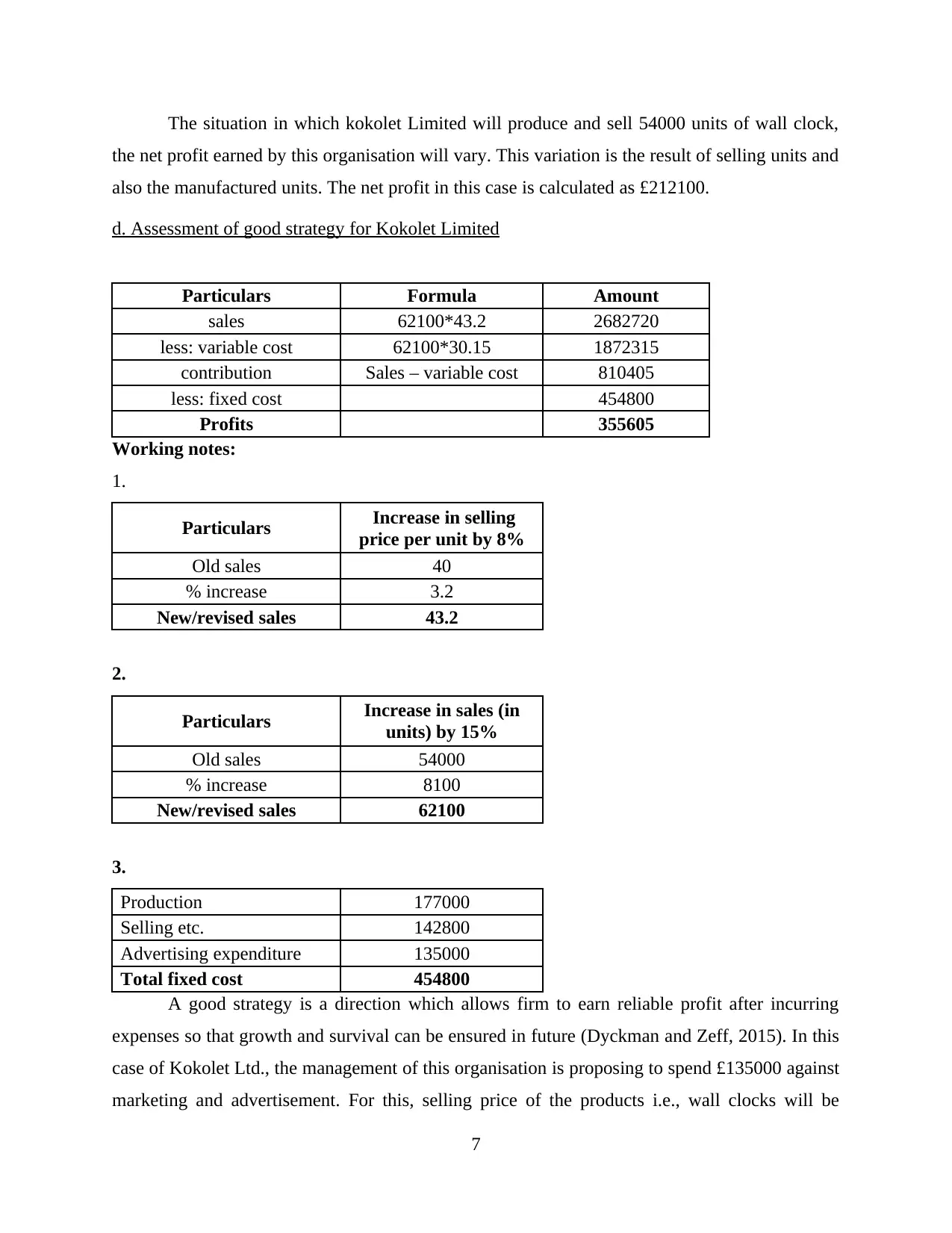
The situation in which kokolet Limited will produce and sell 54000 units of wall clock,
the net profit earned by this organisation will vary. This variation is the result of selling units and
also the manufactured units. The net profit in this case is calculated as £212100.
d. Assessment of good strategy for Kokolet Limited
Particulars Formula Amount
sales 62100*43.2 2682720
less: variable cost 62100*30.15 1872315
contribution Sales – variable cost 810405
less: fixed cost 454800
Profits 355605
Working notes:
1.
Particulars Increase in selling
price per unit by 8%
Old sales 40
% increase 3.2
New/revised sales 43.2
2.
Particulars Increase in sales (in
units) by 15%
Old sales 54000
% increase 8100
New/revised sales 62100
3.
Production 177000
Selling etc. 142800
Advertising expenditure 135000
Total fixed cost 454800
A good strategy is a direction which allows firm to earn reliable profit after incurring
expenses so that growth and survival can be ensured in future (Dyckman and Zeff, 2015). In this
case of Kokolet Ltd., the management of this organisation is proposing to spend £135000 against
marketing and advertisement. For this, selling price of the products i.e., wall clocks will be
7
the net profit earned by this organisation will vary. This variation is the result of selling units and
also the manufactured units. The net profit in this case is calculated as £212100.
d. Assessment of good strategy for Kokolet Limited
Particulars Formula Amount
sales 62100*43.2 2682720
less: variable cost 62100*30.15 1872315
contribution Sales – variable cost 810405
less: fixed cost 454800
Profits 355605
Working notes:
1.
Particulars Increase in selling
price per unit by 8%
Old sales 40
% increase 3.2
New/revised sales 43.2
2.
Particulars Increase in sales (in
units) by 15%
Old sales 54000
% increase 8100
New/revised sales 62100
3.
Production 177000
Selling etc. 142800
Advertising expenditure 135000
Total fixed cost 454800
A good strategy is a direction which allows firm to earn reliable profit after incurring
expenses so that growth and survival can be ensured in future (Dyckman and Zeff, 2015). In this
case of Kokolet Ltd., the management of this organisation is proposing to spend £135000 against
marketing and advertisement. For this, selling price of the products i.e., wall clocks will be
7
Paraphrase This Document
Need a fresh take? Get an instant paraphrase of this document with our AI Paraphraser
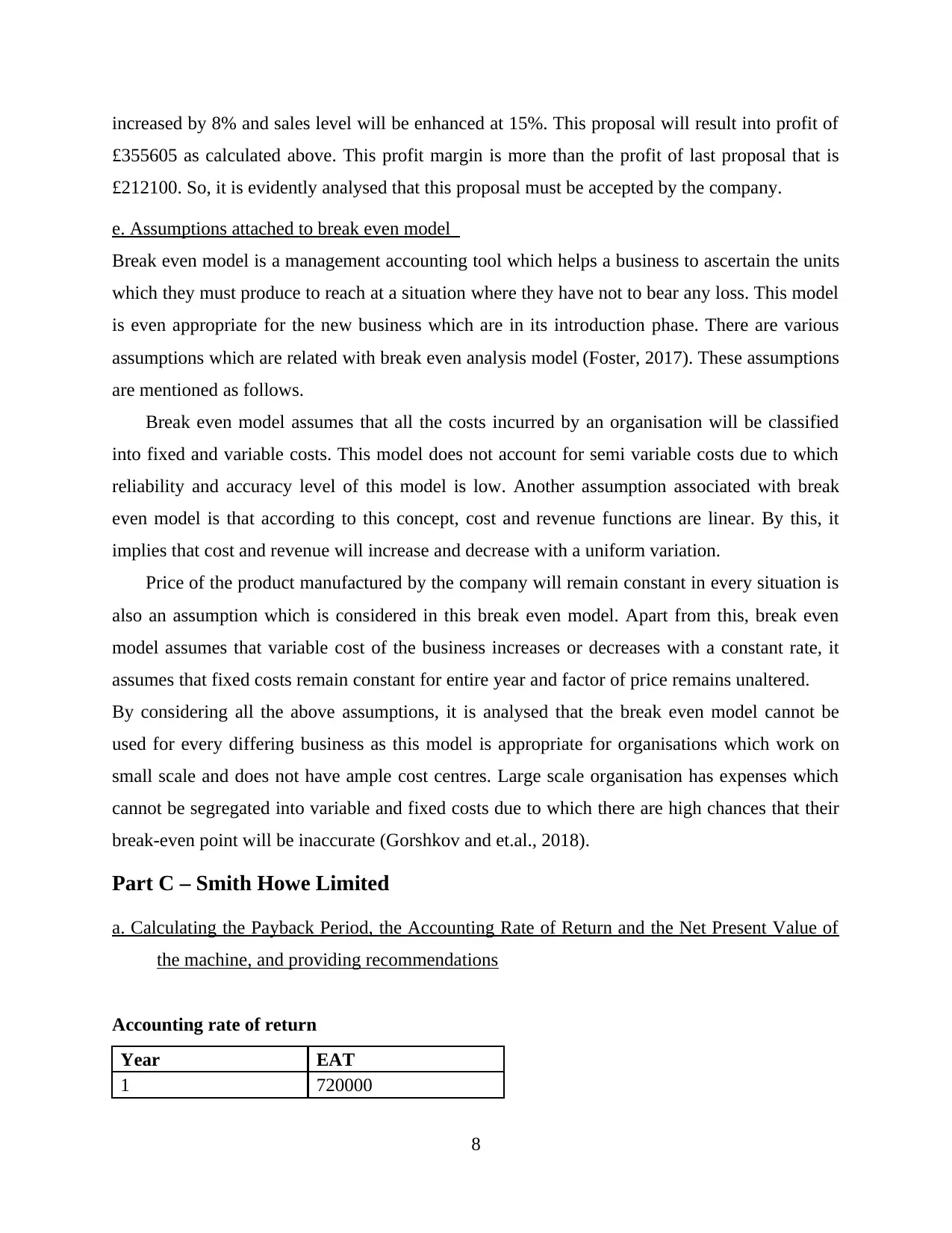
increased by 8% and sales level will be enhanced at 15%. This proposal will result into profit of
£355605 as calculated above. This profit margin is more than the profit of last proposal that is
£212100. So, it is evidently analysed that this proposal must be accepted by the company.
e. Assumptions attached to break even model
Break even model is a management accounting tool which helps a business to ascertain the units
which they must produce to reach at a situation where they have not to bear any loss. This model
is even appropriate for the new business which are in its introduction phase. There are various
assumptions which are related with break even analysis model (Foster, 2017). These assumptions
are mentioned as follows.
Break even model assumes that all the costs incurred by an organisation will be classified
into fixed and variable costs. This model does not account for semi variable costs due to which
reliability and accuracy level of this model is low. Another assumption associated with break
even model is that according to this concept, cost and revenue functions are linear. By this, it
implies that cost and revenue will increase and decrease with a uniform variation.
Price of the product manufactured by the company will remain constant in every situation is
also an assumption which is considered in this break even model. Apart from this, break even
model assumes that variable cost of the business increases or decreases with a constant rate, it
assumes that fixed costs remain constant for entire year and factor of price remains unaltered.
By considering all the above assumptions, it is analysed that the break even model cannot be
used for every differing business as this model is appropriate for organisations which work on
small scale and does not have ample cost centres. Large scale organisation has expenses which
cannot be segregated into variable and fixed costs due to which there are high chances that their
break-even point will be inaccurate (Gorshkov and et.al., 2018).
Part C – Smith Howe Limited
a. Calculating the Payback Period, the Accounting Rate of Return and the Net Present Value of
the machine, and providing recommendations
Accounting rate of return
Year EAT
1 720000
8
£355605 as calculated above. This profit margin is more than the profit of last proposal that is
£212100. So, it is evidently analysed that this proposal must be accepted by the company.
e. Assumptions attached to break even model
Break even model is a management accounting tool which helps a business to ascertain the units
which they must produce to reach at a situation where they have not to bear any loss. This model
is even appropriate for the new business which are in its introduction phase. There are various
assumptions which are related with break even analysis model (Foster, 2017). These assumptions
are mentioned as follows.
Break even model assumes that all the costs incurred by an organisation will be classified
into fixed and variable costs. This model does not account for semi variable costs due to which
reliability and accuracy level of this model is low. Another assumption associated with break
even model is that according to this concept, cost and revenue functions are linear. By this, it
implies that cost and revenue will increase and decrease with a uniform variation.
Price of the product manufactured by the company will remain constant in every situation is
also an assumption which is considered in this break even model. Apart from this, break even
model assumes that variable cost of the business increases or decreases with a constant rate, it
assumes that fixed costs remain constant for entire year and factor of price remains unaltered.
By considering all the above assumptions, it is analysed that the break even model cannot be
used for every differing business as this model is appropriate for organisations which work on
small scale and does not have ample cost centres. Large scale organisation has expenses which
cannot be segregated into variable and fixed costs due to which there are high chances that their
break-even point will be inaccurate (Gorshkov and et.al., 2018).
Part C – Smith Howe Limited
a. Calculating the Payback Period, the Accounting Rate of Return and the Net Present Value of
the machine, and providing recommendations
Accounting rate of return
Year EAT
1 720000
8
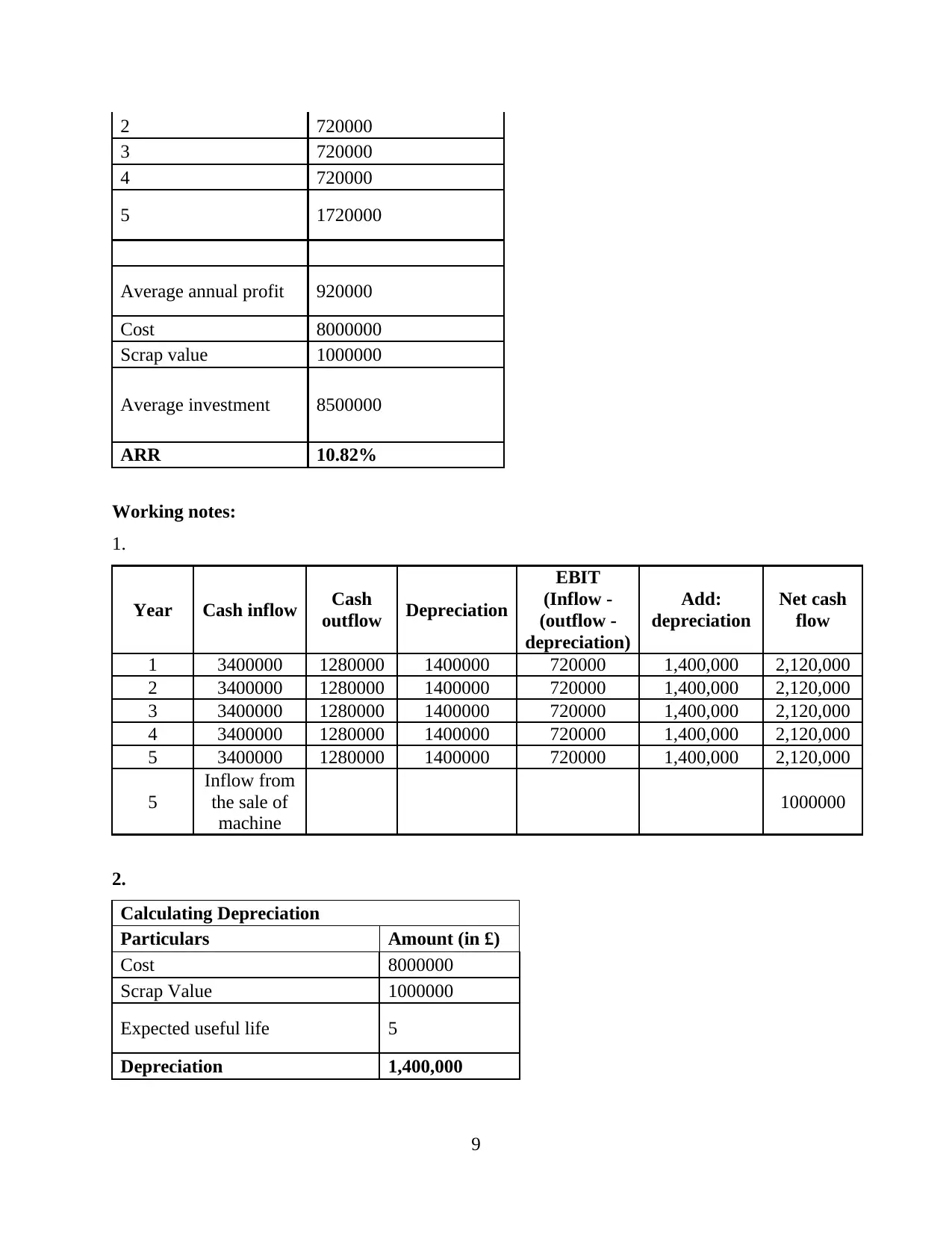
2 720000
3 720000
4 720000
5 1720000
Average annual profit 920000
Cost 8000000
Scrap value 1000000
Average investment 8500000
ARR 10.82%
Working notes:
1.
Year Cash inflow Cash
outflow Depreciation
EBIT
(Inflow -
(outflow -
depreciation)
Add:
depreciation
Net cash
flow
1 3400000 1280000 1400000 720000 1,400,000 2,120,000
2 3400000 1280000 1400000 720000 1,400,000 2,120,000
3 3400000 1280000 1400000 720000 1,400,000 2,120,000
4 3400000 1280000 1400000 720000 1,400,000 2,120,000
5 3400000 1280000 1400000 720000 1,400,000 2,120,000
5
Inflow from
the sale of
machine
1000000
2.
Calculating Depreciation
Particulars Amount (in £)
Cost 8000000
Scrap Value 1000000
Expected useful life 5
Depreciation 1,400,000
9
3 720000
4 720000
5 1720000
Average annual profit 920000
Cost 8000000
Scrap value 1000000
Average investment 8500000
ARR 10.82%
Working notes:
1.
Year Cash inflow Cash
outflow Depreciation
EBIT
(Inflow -
(outflow -
depreciation)
Add:
depreciation
Net cash
flow
1 3400000 1280000 1400000 720000 1,400,000 2,120,000
2 3400000 1280000 1400000 720000 1,400,000 2,120,000
3 3400000 1280000 1400000 720000 1,400,000 2,120,000
4 3400000 1280000 1400000 720000 1,400,000 2,120,000
5 3400000 1280000 1400000 720000 1,400,000 2,120,000
5
Inflow from
the sale of
machine
1000000
2.
Calculating Depreciation
Particulars Amount (in £)
Cost 8000000
Scrap Value 1000000
Expected useful life 5
Depreciation 1,400,000
9
⊘ This is a preview!⊘
Do you want full access?
Subscribe today to unlock all pages.

Trusted by 1+ million students worldwide
1 out of 18
Related Documents
Your All-in-One AI-Powered Toolkit for Academic Success.
+13062052269
info@desklib.com
Available 24*7 on WhatsApp / Email
![[object Object]](/_next/static/media/star-bottom.7253800d.svg)
Unlock your academic potential
Copyright © 2020–2025 A2Z Services. All Rights Reserved. Developed and managed by ZUCOL.





